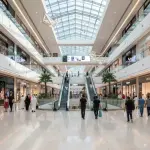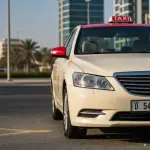Dubai, a global beacon of ambition and futuristic vision, rises majestically from the heart of the Arabian Desert. Its skyline, punctuated by architectural marvels and engineering feats, speaks volumes about human ingenuity. Yet, beneath the gleaming surfaces of its skyscrapers lies a silent, continuous battle against an formidable natural adversary: the relentless, scorching heat of the desert. With summer temperatures routinely soaring above 45°C (113°F) and often accompanied by stifling humidity, the very idea of a vibrant outdoor life might seem paradoxical. However, Dubai has not only made it possible but has perfected the art of creating pockets of comfort, transforming sweltering urban landscapes into refreshingly livable spaces.
This remarkable achievement goes far beyond mere air conditioning inside buildings. It's a sophisticated, multi-faceted strategy of urban climate control, a testament to innovative engineering, meticulous urban planning, and a deep understanding of environmental dynamics. This blog post will delve into the ingenious methods Dubai employs to defy the desert's fiery embrace, revealing the unseen technologies and design principles that allow this desert city to flourish year-round.
The Unyielding Challenge: Understanding Dubai's Unique Climatic Extremes
To truly grasp the monumental effort behind Dubai’s climate control, one must first comprehend the severity of its natural environment. The city experiences prolonged summers, typically from May to September, characterized by intensely high temperatures combined with significant humidity levels driven by its coastal proximity. This combination creates a particularly harsh "feels like" temperature, making prolonged outdoor exposure uncomfortable, impractical, and potentially dangerous. The abundant sunlight also leads to a severe "urban heat island" effect, where vast expanses of concrete, asphalt, and glass absorb and re-radiate heat, further intensifying the already extreme ambient temperatures.
For a city that prides itself on outdoor attractions, vast theme parks, bustling promenades, and world-class events, mitigating this extreme heat is not merely a convenience but an existential imperative. It’s about ensuring continuous economic activity, maintaining resident well-being, and sustaining its image as a premier global tourist destination.
The Vanguard of Comfort: Active Cooling Technologies
Dubai's primary line of defense against the heat involves an impressive array of active cooling technologies that directly modify the atmospheric conditions of outdoor public spaces. These systems are strategically deployed, turning previously unbearable areas into genuinely pleasant zones.
- Misting Systems: The Evaporative Oasis: Ubiquitous in outdoor dining areas, pedestrian walkways, public parks, and recreational zones across Dubai, misting systems are arguably the most visually recognizable active cooling solution. These systems work on a simple yet highly effective principle: evaporative cooling. Tiny nozzles atomize water into ultra-fine mist particles, often as small as 5 to 10 microns, which are then dispersed into the air. As these microscopic water droplets evaporate, they absorb latent heat from the surrounding environment, thereby significantly lowering the air temperature. Depending on humidity levels, these systems can reduce localized temperatures by as much as 10-15°C (18-27°F). The sensation is not one of getting wet, but rather of walking into a refreshing, slightly cooler microclimate, providing instant and noticeable relief from the oppressive heat. They are a common sight in areas like City Walk, La Mer, and various outdoor souks, making them enjoyable even during the shoulder seasons.
- Chilled Water Networks: Cooling from the Ground Up: One of Dubai's most ingenious and less obvious cooling strategies involves subterranean chilled water networks. Beneath the meticulously manicured lawns of golf courses, the bustling pathways of theme parks, and even the sands of man-made beaches (like those at the Burj Al Arab), lies an intricate web of pipes circulating super-cooled water. This innovative system effectively cools the ground surface, preventing it from radiating heat upwards. Imagine walking barefoot on a beach in peak summer without scorching your feet – this is a direct result of such technology. Similarly, cooled pavements reduce the heat stored and re-radiated by concrete, making strolls along promenades, such as the Marina Walk or those surrounding the Dubai Canal, considerably more comfortable even when the sun is high. This technology is also vital for outdoor sports facilities, ensuring pitches and tracks remain playable.
- Outdoor Air Conditioning: Strategic Deployment for Events: While a significant energy consumer, outdoor air conditioning units are strategically utilized for specific high-profile events, large outdoor venues, and areas requiring precise temperature control. These are not merely large fans; they are sophisticated climate control units designed to cool open-air spaces. You might find them deployed at major expos, outdoor concert arenas, or during grand public gatherings. For instance, the Dubai Expo 2020 (held in 2021-22) leveraged extensive outdoor cooling systems, including misting and targeted air delivery, to ensure visitor comfort across its vast grounds. Such systems are integrated with smart sensors to optimize performance and conserve energy when conditions allow, providing critical comfort during peak heat.
- Advanced Ventilation and Air Circulation Systems: In semi-enclosed public spaces, such as covered walkways, arcades within shopping districts, or large open-plan waiting areas, sophisticated ventilation and mechanical air circulation systems play a pivotal role. These systems are designed to prevent the stagnation of hot, humid air. They might draw in cooler air from shaded areas, utilize powerful fans to create cross-ventilation, or employ evaporative coolers in conjunction with traditional AC. The goal is to ensure a continuous flow of air, which helps dissipate heat and moisture, providing a more breathable and comfortable atmosphere without fully enclosing the space.
The Wisdom of Design: Passive Cooling Strategies
Beyond active technological interventions, Dubai also consciously integrates traditional wisdom and modern architectural principles to passively mitigate heat gain. These strategies focus on preventing heat from accumulating in the first place, reducing the reliance on energy-intensive active cooling.
- Strategic Shading and Urban Canopies: Drawing inspiration from ancient Islamic architecture's effective use of shade, modern Dubai designs prioritize providing ample shade in public areas. Overhangs, deep recesses in building facades, and strategically oriented structures minimize direct solar exposure. Furthermore, extensive urban canopies, pergolas, and architectural elements are designed to cast long shadows over pedestrian paths, reducing surface temperatures and protecting individuals from direct sun. The dense clustering of skyscrapers in areas like Downtown Dubai or the Marina also inadvertently provides significant self-shading during various parts of the day, creating cooler microclimates at ground level.
- The Psychological and Physical Cooling of Water Features: Dubai’s landscape is dotted with magnificent fountains, serene canals, and sprawling artificial lakes. While undeniably aesthetic, these water features serve a crucial practical purpose in climate regulation. The large surface area of water allows for evaporative cooling, subtly lowering the ambient temperature of the surrounding air. The visual and auditory presence of water also contributes a profound psychological cooling effect, creating a perception of freshness and tranquility amidst the desert environment. The Dubai Fountain, the vast waterways of Madinat Jumeirah, and the Dubai Canal are prime examples where water is integrated as both a visual spectacle and a functional cooling element.
- Green Infrastructure: Nature's Own Air Conditioning: The proliferation of parks, gardens, and vast green spaces across Dubai is not merely for aesthetics; it’s a critical component of its passive cooling strategy. Trees and plants provide natural shade, reducing the absorption of solar radiation by urban surfaces. More importantly, through a process called transpiration, plants release water vapor into the atmosphere, which contributes to evaporative cooling, akin to nature's own misting system. These green pockets act as "cool islands" within the urban fabric, mitigating the urban heat island effect by absorbing less heat and releasing more moisture than concrete and asphalt. Developments like Dubai Miracle Garden, Dubai Garden Glow, and numerous community parks showcase this commitment to greening the desert.
- Innovative Materials and Reflective Surfaces: Urban planners and architects in Dubai are increasingly exploring and implementing advanced materials that contribute to passive cooling. Cool pavement technologies, which use materials that reflect more solar radiation and absorb less heat than traditional asphalt, are being trialed. Similarly, building facades are designed with highly reflective surfaces or incorporate advanced coatings that minimize heat gain. These materials prevent heat from building up in the urban environment, reducing the overall ambient temperature and the need for excessive active cooling.
The Drive Towards Sustainability and a Cooler Future
While Dubai's pioneering climate control solutions offer immense comfort, their energy demands are substantial. Recognizing the imperative for long-term sustainability, the city is aggressively pursuing strategies to mitigate this impact:
- Integration with Renewable Energy Sources: A cornerstone of Dubai’s Clean Energy Strategy 2050 is to power its energy-intensive infrastructure, including desalination plants and urban cooling systems, with renewable sources, primarily solar. Gigantic solar parks like the Mohammed bin Rashid Al Maktoum Solar Park are crucial in this endeavor, aiming to provide a significant portion of the city's power from clean sources. This transition helps to reduce the carbon footprint associated with creating an "oasis of comfort."
- Smart Grid and AI-Powered Optimization: Dubai Electricity and Water Authority (DEWA) is at the forefront of developing a smart grid that leverages Artificial Intelligence (AI) and advanced analytics. AI algorithms continuously monitor weather conditions, foot traffic, and energy prices to optimize the operation of cooling systems, ensuring they run only when and where absolutely necessary. Predictive analytics can forecast demand spikes, allowing for pre-emptive adjustments and minimizing energy waste. This intelligent optimization is vital for maintaining comfort while managing resource consumption.
- Continuous Research and Development: Dubai actively invests in research and development for next-generation cooling technologies. This includes exploring novel phase-change materials, highly efficient heat exchangers, advanced insulation techniques, and innovative urban planning concepts that maximize natural ventilation and shading. The goal is to find solutions that are not only effective but also increasingly sustainable and cost-efficient.
Conclusion: Dubai's Blueprint for a Livable Desert Future
Dubai's relentless pursuit of urban comfort in the face of extreme desert heat is a remarkable narrative of vision meeting innovation. It's a grand experiment in creating livable, thriving environments where nature poses a fundamental challenge. By strategically deploying a sophisticated blend of active cooling technologies – from pervasive misting systems and chilled pavements to targeted outdoor air conditioning – and intelligently integrating passive design principles like shading, water features, and green infrastructure, Dubai has managed to turn a harsh climate into a manageable one.
This comprehensive approach is more than just technological prowess; it's a testament to urban resilience and foresight. As global temperatures rise and cities worldwide grapple with increasing heat stress, Dubai's "oasis of comfort" serves as a compelling blueprint. It demonstrates that with bold vision, significant investment in research and development, and a steadfast commitment to both human well-being and environmental sustainability, even the most challenging climates can be made hospitable, proving that the desert city's shimmering future is not just sustainable, but truly comfortable.










